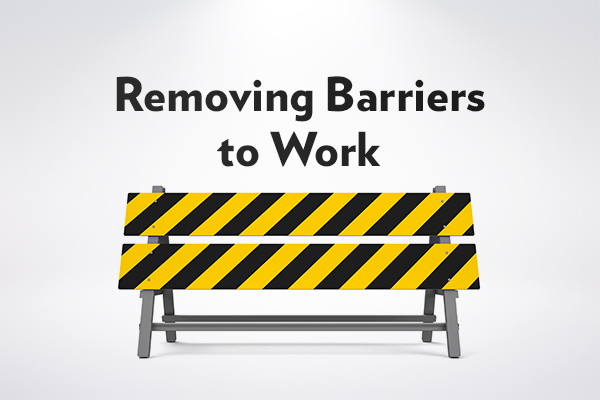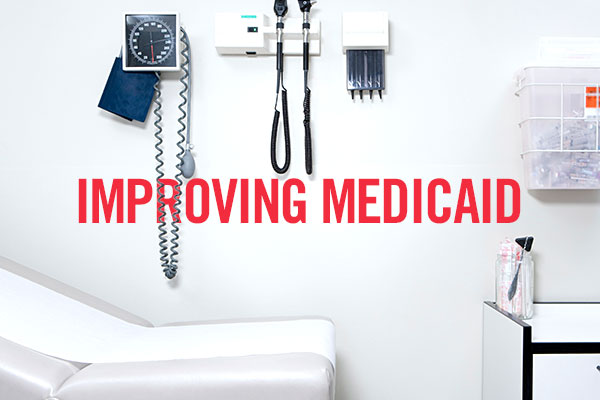Key Findings:
- Pennsylvania’s Medicaid program has grown to record levels. From 2010 to 2019, Medicaid enrollment grew from 2.3 million to 2.8 million, a 26% increase.
- Medicaid growth has far outpaced population growth in Pennsylvania, with more than six individuals added to Medicaid for every new resident between 2010 and 2019.
- For every additional worker that Pennsylvania added to its workforce, it added more than three people to Medicaid.
- State-only Medicaid spending grew by 83% since 2010, reaching nearly $14 billion in 2019.
- Nearly 40% of Pennsylvania’s budget now goes to Medicaid, the fourth highest of all the states and more than New York and California.
Recommendations:
- Pennsylvania can make Medicaid sustainable by implementing a commonsense work requirement for able-bodied adults on Medicaid.
- Pennsylvania can protect services for vulnerable Medicaid recipients by strengthening front-end eligibility verification and more frequently utilizing data the state already collects to ensure enrollees are eligible.
- Pennsylvania can use savings from these commonsense reforms to reduce the waiting list for community-based services for those with intellectual disabilities.
Background
Across the country, states are grappling with unprecedented growth in their Medicaid programs. Enrollment has spiraled out of control, fueled further by Obamacare's Medicaid expansion for able-bodied adults.[1] This enrollment surge has led to skyrocketing costs for taxpayers and is threatening services for truly needy Medicaid populations. Indeed, states now spend nearly one out of every three dollars in their budgets on Medicaid.[2]
To make matters worse, state Medicaid programs are susceptible to widespread fraud: The U.S. Department of Health and Human Services estimates that roughly 10% of all Medicaid spending is improper, and the vast majority of this improper spending is due to eligibility errors.[3]
Unfortunately, the Commonwealth of Pennsylvania is a Medicaid leader in all the wrong ways. Medicaid enrollment has skyrocketed over the last decade, far outpacing population growth, and the state ranks fourth in the share of the state budget consumed by Medicaid. In July, Medicaid enrollment reached an all-time high crossing the 3 million mark.[4]
Yet despite this unprecedented growth, Medicaid remains a sub-par program, to put it mildly. Medicaid has not meaningfully improved physical health outcomes. More than 15,000 Pennsylvanians remain on Medicaid waiting lists, and, tragically, at least 154 individuals on those lists have died since the state expanded Medicaid to able-bodied adults through Obamacare.[5],[6],[7]
Without an immediate course correction, Pennsylvania’s Medicaid program is headed off the tracks, if it is not already.
With unemployment surging from 4.7% to 16% in April 2020, it will be increasingly important that the state use every tool at its disposable to shore up the foundation of its Medicaid program.[8]
Failure to act now could easily turn Pennsylvania into New York, a state that was facing a $6 billion budget shortfall well before the COVID-19 economic downturn, driven by years of Medicaid eligibility expansions and mismanagement.[9]
While federal rules tie the hands of the state in some ways, the state does have tools at its disposal to tackle Medicaid growth and fraud to ensure the program’s future sustainability.
Click here to view the full report
About the Author: Nicholas Horton has provided policy analysis, legislative testimony, and policy briefings on Medicaid expansion and welfare reform in more than 20 states and Washington, D.C. His commentary and analysis have been featured in Forbes, The Hill, National Review Online, Washington Examiner, and Townhall.com, among other national outlets. Nic is the research director at the Foundation for Government Accountability. Before joining FGA, he served as editor of TheArkansasProject.com and as policy analyst for the Advance Arkansas Institute. He holds a Bachelor of Science in Public Administration and a Master of Business Administration from Harding University
[1]Jonathan Ingram and Nicholas Horton, “ObamaCare expansion enrollment is shattering projections,” Foundation for Government Accountability (2016), https://thefga.org/research/obamacare-expansion-enrollment-is-shattering-projections-2/.
[2]Nicholas Horton, “The Medicaid Pac-man: How Medicaid is consuming state budgets,” Foundation for Government Accountability (2019), https://thefga.org/research/medicaid-pac-man/.
[3]Victoria Eardley and Jonathan Ingram, “How the Trump administration can crack down on Medicaid fraud,” Foundation for Government Accountability (2018), https://thefga.org/research/medicaid-fraud-reform-trump-administration/.
[4]Pennsylvania Department of Human Services, “Medical Assistance, Food Stamps and Cash Assistance Statistics Reports,” Office of Income Maintenance (2020), http://listserv.dpw.state.pa.us/ma-food-stamps-and-cash-stats.html.
[5]Katherine Baicker et al., “The Oregon experiment—effects of Medicaid on clinical outcomes,” New England Journal of Medicine (2013), https://www.nejm.org/doi/full/10.1056/NEJMsa1212321.
[6]The PA Waiting List Campaign, “Prioritization of Urgency of Need for Services March 31, 2020 (PUNS),” (2020), https://pawaitinglistcampaign.org/puns-as-of-3-31-2020/.
[7]According to the Pennsylvania Department of Human Services, 154 individuals on state waiting lists died from January 2015 through early June 2017. See, e.g., Nicholas Horton, “Waiting for help: the Medicaid waiting list crisis,” Foundation for Government Accountability (2018), https://thefga.org/research/medicaid-waiting-list/.
[8]Bureau of Labor Statistics, “Local Area Unemployment Statistics: Pennsylvania labor force, seasonally adjusted,” U.S. Department of Labor (2020), https://data.bls.gov/timeseries/LASST420000000000003.
[9]Nolan Hicks et al., “Cuomo targets Medicaid spending at local level to close $6 billion budget deficit,” New York Post (2020), https://nypost.com/2020/01/08/cuomo-targets-medicaid-spending-at-local-level-to-close-6b-budget-deficit/.
RELATED : JOBS & ECONOMY, HEALTH CARE, WELFARE, TAXES & SPENDING, MEDICAID, PENNSYLVANIA STATE BUDGET





